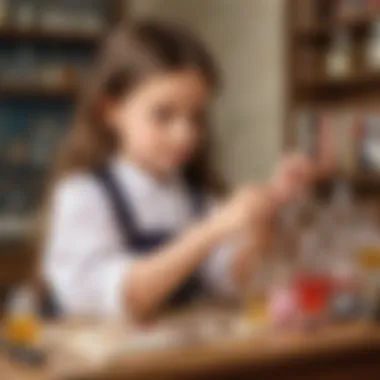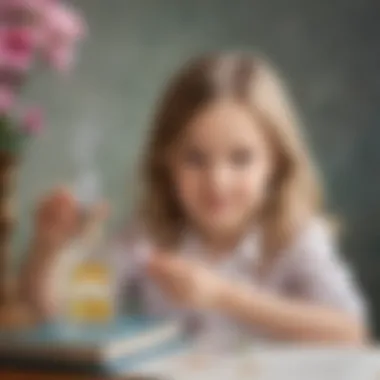Unlocking Creativity: A Child's Guide to Crafting Unique Perfumes


Science Fun Facts
Curious minds are perennially intrigued by the wonders of science, especially when aromas and fragrances intertwine to create captivating scents. Did you know that the sense of smell is intricately linked to memory, allowing certain scents to evoke vivid recollections of past experiences? Exploring the realm of perfumery not only stimulates creativity but also enhances our understanding of how our olfactory system plays a vital role in our daily lives.
Discover the Wonders of Science
Venture into the realm of fragrance creation, where young scientists can unravel the secrets behind their favorite perfumes. By blending various essential oils and aromatic compounds, children can delve into the world of chemistry and physics, uncovering the scientific principles that govern the art of perfumery. Through hands-on experimentation and exploration, little Science enthusiasts will discover the fascinating connections between scent molecules and the sensory experiences they evoke.
Science Quiz Time
Engage in an interactive journey of discovery through perfumery-themed quizzes and brain teasers. Test your knowledge on the chemical components of different scents, unravel the mysteries of fragrance families, and challenge yourself with fun puzzles that tease your understanding of aromatics. From multiple-choice questions to exciting gamification elements, embark on a scent-sational quiz experience that will sharpen your scientific skills and broaden your perfumery horizons.
Science Experiment Showcase
Prepare for a fragrant adventure with hands-on perfume-making experiments that combine science and artistry. Follow step-by-step instructions to concoct your personalized scents, exploring a spectrum of fragrances that appeal to your senses. With safety tips and a comprehensive materials list at your disposal, blend creativity with precaution as you embark on this aromatic journey of self-expression and olfactory discovery.
Introduction to Perfumery
In the world of perfumery, understanding the intricate art of scent composition is like unraveling a beautiful mystery. It is not merely about creating a pleasant fragrance but delving deeper into the realms of olfactory senses. Introducing children to this captivating domain opens up avenues of creativity and scientific exploration that can shape their understanding of the sensory world around them. Learning the basics of perfumery provides youngsters with a unique blend of artistry and chemistry, stimulating their curiosity and nurturing their cognitive processes.
Exploring the World of Scents
Understanding the power of scent
Exploring the power of scent is a fascinating journey into how our sense of smell impacts our emotions and memories. By comprehending the influence of various fragrances on our brain, children can gain insights into the subtleties of human perception. Understanding scent's power allows them to appreciate the nuances of different aromas and how they interact with one another to create harmonious blends. This knowledge forms the foundation for crafting well-balanced and enticing perfumes.
History of perfumery
Delving into the rich history of perfumery unveils a tapestry of cultures, traditions, and innovations spanning millennia. Learning about the origins of perfume not only provides a glimpse into the artistry of ancient civilizations but also showcases how perfumery has evolved over time. Recognizing the historical significance of scents instills a sense of heritage and appreciation for the craftsmanship behind every fragrance, connecting children to a timeless legacy of olfactory artistry.
Basic Concepts in Perfume Making
Aroma notes and categories


The realm of aroma notes and categories serves as the building blocks of perfume creation, akin to the colors on an artist's palette. Understanding the distinctive characteristics of various scent families such as floral, citrus, or oriental equips young enthusiasts with a language to express their olfactory preferences. By grasping the concept of aroma categories, children can articulate their sensory experiences and translate them into aromatic blends that reflect their individuality and creativity.
Role of essential oils
Essential oils play a pivotal role in perfume making, offering a concentrated essence extracted from natural botanical sources. Delving into the realm of essential oils introduces children to the potency and diversity of plant-based fragrances, from soothing lavender to zesty citrus notes. Understanding how essential oils contribute to the longevity and complexity of a fragrance empowers young perfumers to experiment with different botanical essences, crafting unique scents that resonate with their personal style and preferences.
Getting Started with Your Own Perfume
Startling on the journey of creating your own scented perfume heralds a realm of endless possibilities and olfactory delights. To delve into the world of crafted scents is to embark on a cerebral voyage that engages both mind and senses. Understanding the pivotal role of getting initiated with perfume concoction not only cultivates a sense of creativity but also fosters an appreciation for the intricate art of perfumery. The significance of this phase lies in laying the foundation for the budding perfumers to grasp the essence of scent composition and formulation, setting the stage for experimental exploration and personal expression.
Essential Tools and Ingredients
Perfume Base
Fundamental to any perfume formulation, the perfume base acts as the canvas upon which fragrant masterpieces are painted. Its intrinsic role in perfume crafting is akin to that of a sturdy frame for a painting, providing structure and stability to the final olfactory composition. The key characteristic of a perfume base lies in its ability to carry and enhance the aromatic notes, ensuring a balanced and long-lasting fragrance. This carefully chosen base serves as the cornerstone of perfume creation, offering a versatile foundation to accommodate a myriad of scents. While its advantages include depth and longevity to the scent, some may find its viscosity challenging to work with.
Dilution Agents
In the realm of perfume making, dilution agents play a crucial role in refining the concentration of aromatic oils within the composition. Acting as the harmonizing element, these agents help achieve the desired potency of the perfume while ensuring that the scent is neither overpowering nor faint. The unique feature of dilution agents lies in their ability to fine-tune the intensity of the fragrance, allowing for precision in scent modulation. Their advantages include versatility in customizing scent strength, yet some may find them altering the original aroma profile.
Aromatic Extracts
Aromatic extracts form the heart and soul of perfume creation, infusing each blend with distinct notes and character. These extracts, derived from natural sources like flowers, fruits, spices, and woods, contribute unique olfactory hues to the final perfume. The key characteristic of aromatic extracts is their innate ability to evoke emotions and memories through scent, creating an immersive sensory experience. Their advantages lie in the authenticity and complexity they lend to perfumes, although some may consider their volatility a drawback.
Creating Your Signature Scent
Blending Techniques
The art of blending techniques is an indispensable skill for crafting a distinctive and harmonious perfume. By deftly combining various aromatic elements, perfumers can create nuanced layers of scent that unfold elegantly over time. The key characteristic of blending techniques is their profound impact on the overall olfactory profile, defining the personality and allure of the perfume. Their unique feature lies in the intricate balance they bring to fragrant compositions, offering depth and complexity. While their advantages include limitless creative possibilities, mastering blending techniques may require patience and practice.
Personalizing Your Fragrance
Personalization marks the pinnacle of perfume creation, allowing individuals to imprint their unique identity on a fragrance. By adding personal touches like favorite scents or meaningful notes, perfumers transform a blend into a bespoke olfactory masterpiece. The key characteristic of personalizing fragrances is the emotional connection it forges between the scent and its creator, making each perfume a reflection of personal taste and style. Their advantages encompass tailored olfactory experiences and a sense of ownership, yet some may find the process of personalization daunting in achieving balance.


Experimenting with Aromas
Experimenting with Aromas is a pivotal aspect in the realm of perfume creation detailed in this discourse. Aromas play a fundamental role in crafting unique fragrance compositions, allowing young enthusiasts to explore a myriad of scents and their interactions. By engaging in the experimentation of aromas, children aged 6-12 can enhance their olfactory senses and gain insight into the art of perfumery. Understanding different fragrance combinations and their harmonious blends is essential to creating a personalized scent that reflects one's creativity and preferences.
Floral and Fruity Scents
Delving into Floral and Fruity scents introduces young minds into the world of fresh and vibrant fragrances. These scents offer a sense of elegance and youthfulness, perfect for those looking to create light and airy perfume compositions. Floral notes bring forth characteristics of blooming flowers, while fruity tones add a touch of sweetness and zest. Incorporating Floral and Fruity scents into perfume blends can evoke feelings of joy and freshness. However, a common consideration lies in balancing these scents to avoid an overpowering aroma that may be too sweet or intense for some individuals.
Spicy and Woody Tones
Exploration of Spicy and Woody tones introduces complexity and depth to perfume formulations in this educational narrative. Spicy notes exude warmth and sophistication, ideal for creating rich and alluring fragrances. Conversely, woody tones provide a sense of grounding and maturity to perfume blends. Integrating Spicy and Woody tones into scent combinations can result in a unique olfactory experience that appeals to varied preferences. Yet, it is crucial to note that blending these tones requires a delicate balance to prevent an overwhelming or unbalanced aroma profile.
Understanding Scent Balance
Delving into the realm of scent balance unveils the intricate art of perfume construction in this enriching guide. Recognizing the significance of top, middle, and base notes is essential for creating well-rounded fragrance compositions. Top notes provide the initial impression, followed by the heart or middle notes that form the core character of the perfume. Base notes offer longevity and depth to the scent, ensuring a lasting olfactory experience. Achieving harmony among these notes is key to developing a balanced and long-lasting fragrance that resonates with one's olfactory preferences.
Creating Harmonious Blends
Mastering the craft of creating harmonious blends empowers young perfumers to craft seamless and enticing fragrance profiles. By skillfully combining various aroma notes, individuals can achieve a cohesive and pleasant scent composition. Creating harmonious blends involves experimenting with different scent intensities, undertones, and accords to produce a fragrance that seamlessly transitions from top to base notes. While the process of blending scents offers endless possibilities for creativity, it necessitates attention to detail and precision to ensure the final product embodies a harmonious fusion of aromas.
Safety Measures and Precautions
Safety measures and precautions are crucial aspects to consider when embarking on the journey of creating your own scented perfume. In the world of perfumery, understanding how to handle essential oils safely and ensuring proper storage of your creations is paramount. By implementing these precautions, young perfume enthusiasts can enjoy their craft responsibly and with peace of mind. Working with aromatic ingredients requires a careful approach to ensure both the quality of the perfume and the safety of the individuals involved. It is essential for little science buddies to grasp the significance of safety measures and precautions to foster a positive and secure perfume-making experience.
Handling Essential Oils Safely
Dilution guidelines
Dilution guidelines play a fundamental role in the perfume-making process for young science enthusiasts. These guidelines dictate the proper ratios at which essential oils should be mixed with base ingredients to achieve the desired scent without causing irritation or sensitivities. Diluting essential oils not only enhances the longevity and potency of the fragrance but also minimizes the risk of adverse skin reactions. Little science buddies are encouraged to follow specific dilution ratios meticulously to ensure a safe and enjoyable perfume-making experience. By understanding and adhering to these guidelines, children can navigate the world of essential oils confidently and responsibly.
Skin patch testing
Skin patch testing is a critical step in ensuring the safety and compatibility of a perfume with an individual's skin. This method involves applying a small amount of the perfume mixture to a patch of skin and monitoring for any adverse reactions over a specified period. Through skin patch testing, young perfume creators can identify potential allergens or irritants present in their formulations and make necessary adjustments. This proactive approach empowers children to create perfumes that are not only delightful but also safe for use. By incorporating skin patch testing into their perfume-making process, little science buddies can prioritize both creativity and safety.


Storage and Shelf Life
Proper storage containers
Selecting the right storage containers for your homemade perfumes is essential to maintain their quality and prolong their shelf life. Proper storage containers, such as dark glass bottles with tight-sealing caps, help protect the fragrance from exposure to light and air, preserving its aromatic integrity. By storing perfumes in suitable containers, young perfume enthusiasts can ensure that their creations retain their scent profile and potency over time. Understanding the significance of proper storage containers equips children with the knowledge to care for their perfumes effectively and enjoy them for longer durations.
Maintaining perfume quality
Maintaining perfume quality is a continuous process that involves proper handling, storage, and usage of the created fragrances. By storing perfumes in a cool, dark place away from direct sunlight and fluctuating temperatures, children can safeguard the aromatic properties of their creations. Additionally, ensuring that perfume bottles are tightly sealed and avoiding contamination from other substances can help uphold the quality of the perfumes. Little science buddies are encouraged to maintain a keen eye on their perfume inventory, periodically checking for any changes in scent or appearance that may indicate degradation. By taking proactive measures to maintain perfume quality, young perfumers can enjoy the fruits of their creative labor for an extended period.
Final Touches and Presentation
In the concluding section of this extensive guide on creating scented perfumes for young science enthusiasts, the focus shifts towards the critical aspect of Final Touches and Presentation. This stage is vital as it encapsulates the essence of the perfume-making journey and sets the tone for how the crafted fragrance will be perceived. Final Touches require precision and attention to detail to deliver a polished end product that reflects the creator's vision. Presentation, on the other hand, enhances the overall experience, making the perfume not just a scent but a complete sensory delight for both the creator and those who encounter it.
In the realm of perfume creation, Final Touches elevate a standard homemade product to a professionally finished perfume. These touches encompass elements such as fine-tuning the scent balance, ensuring longevity through proper dilution, and refining the blend to achieve a harmonious olfactory experience. The Presentation aspect involves packaging the perfume attractively, which serves not only aesthetic purposes but also plays a part in preserving the fragrance's integrity.
Considering young science enthusiasts as the target audience, Final Touches and Presentation hold educational value beyond just creating perfumes. They teach attention to detail, creativity in design, and the significance of packaging in product presentation. By delving into these aspects, children not only enjoy the art of perfume-making but also develop skills in aesthetic presentation and finishing, fostering a holistic educational experience.
MarC this segment aptly concludes the perfume-making process, merging artistic flair with scientific precision to culminate in a sensory masterpiece accessible to our young Science Buddies.
Labeling Your Perfume
Creative naming:
Creative Naming plays a crucial role in personalizing and adding character to the crafted perfume. The chosen name can evoke emotions, tell a story, or simply reflect the essence of the fragrance. In the context of this article geared towards children creating their own scents, Creative Naming becomes a fun and engaging activity that allows young minds to express their creativity.
The key characteristic of Creative Naming lies in its ability to give identity to the perfume, making it more than just a blend of scents but a unique creation with its own persona. By encouraging children to come up with imaginative names for their perfumes, we foster individuality, imagination, and linguistic skills.
The unique feature of Creative Naming lies in its potential to spark curiosity and imagination. Children can explore words, meanings, and associations to find the perfect name for their fragrance. This process not only enhances their vocabulary and thinking but also instills a sense of ownership and pride in their creation.
While Creative Naming adds a personalized touch to perfumes, it's essential to guide children in choosing appropriate names that resonate with the fragrance they have formulated. This ensures alignment between scent and title, enhancing the overall experience of perfume creation for our Little Science Buddies.
Designing a personalized label:
Designing a Personalized Label serves as the visual representation of the perfume. It is the first impression of the fragrance and an essential component of the overall presentation. For young creators, designing a label offers an opportunity to showcase their artistic skills and attention to detail.
The key characteristic of Designing a Personalized Label lies in its potential to convey information about the perfume - from the name to the creator's identity. It acts as a gateway for others to understand the essence of the fragrance before even experiencing it, making the visual aspect as significant as the olfactory one.
The unique feature of Designing a Personalized Label is its ability to encapsulate the mood and theme of the perfume. Children can use colors, shapes, and symbols to represent what their scent embodies, creating a visual story that complements the olfactory narrative.
While designing a label adds a personalized and artistic flair to the perfume, it's important to ensure that the information provided is clear, legible, and coherent with the fragrance and its name. This attention to detail enhances the overall presentation of the perfume, making it an enticing sensory experience for both the creator and potential recipients.







